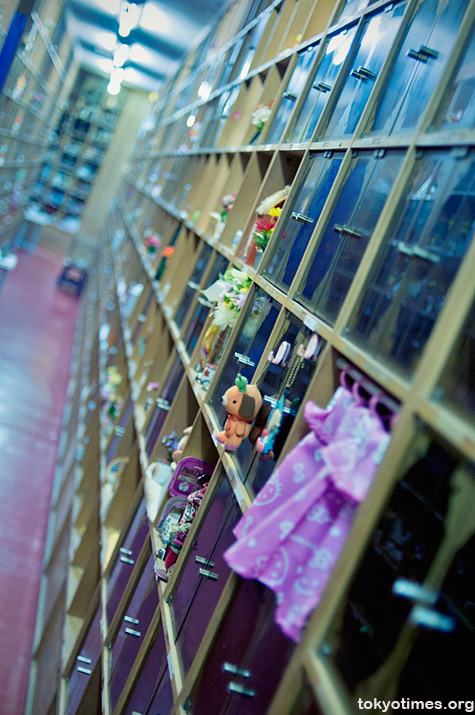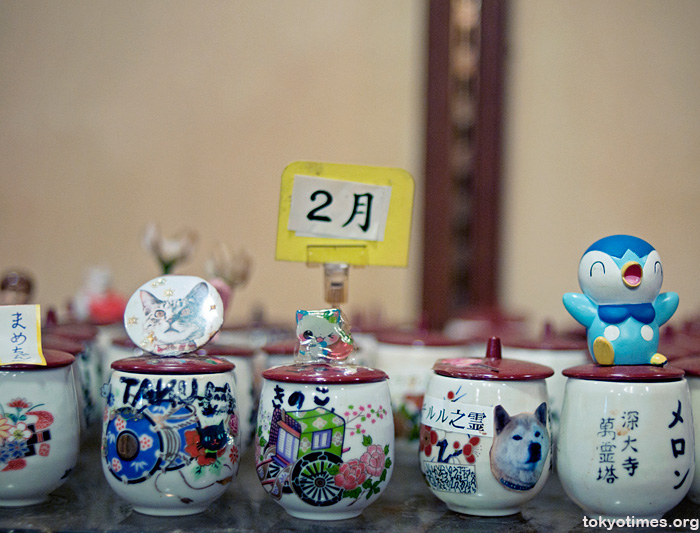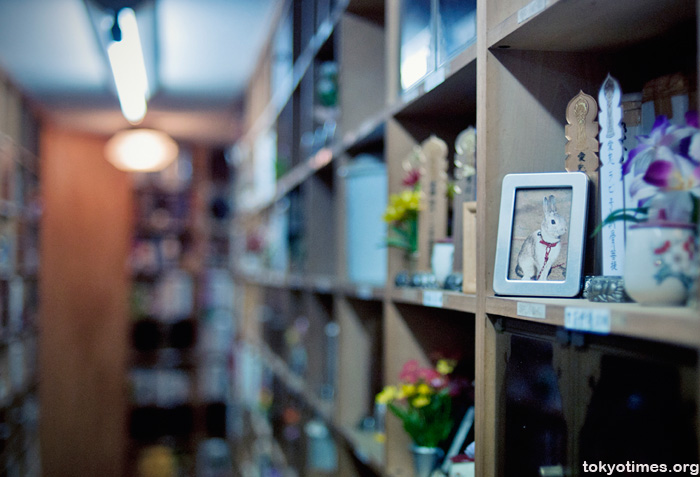By Colin Dickey
A look back at Bones of Contention: Animals and Religion in Contemporary Japan, Barbara R. Ambros, (Baker, 2004).
In 2006, an unmarried, middle aged woman living in Tokyo—“Ms. N.”—began looking for a burial plot for herself. Her parents had recently passed away, and her father’s remains had filled the last plot in the family grave. Rather than seeking more space in an adjacent plot or in the same cemetery, Ms. N. ultimately settled on an urban cemetery in the north of the city, Azusawa Boen, which she was attracted to because it offered “joint-species internment”—that is, she could be buried with her two shih-tzus, to whom she had grown increasingly attached. Despite strong objection from her siblings, Ms. N. had a headstone engraved with the word “Madoi,” meaning “intimate gathering,” along with her name and two paw prints alongside the names of her two dogs—a headstone that clearly indicated that her relationship to her non-human companions had come to eclipse that of her human family.
It’s easy to see this as pathological behavior: a rejection of one’s own family in favor of one’s pets seems a violation of some basic inherent order of the world. The act calls to mind the malicious, parting shot of millionaire hotel queen Leona Helmsley, who in her will left twelve million dollars to her Maltese, Trouble, while leaving nothing to some of her human relatives. But in the case of Ms. N., whose story is just one of many fascinating tales of human attitudes towards pets and mortality that appears in Barbara R. Ambros’ Bones of Contention: Animals and Religion in Contemporary Japan, it’s possible also that her decision is not just the product of some deluded, abject outlier, but a reflection of a more fundamental shift in our attitudes towards death, ritual, and animals.
Pets have long held a liminal space in human culture—less than family, more than animal. The exact emotional space a pet occupies shifts constantly, from culture to culture, and from family to family, and is more or less always in flux. So it’s natural that the idea of pet burial be fraught with various complications: what one sees as a personal tribute to a beloved family member another may see as frivolous and excessively sentimental; what one sees as a touching memorial may strike another as an inappropriate disposal of potentially hazardous biowaste. The kinds of complexities that Errol Morris’ first film, Gates of Heaven, explored surrounding pet burial are fairly universal, and rarely touched upon in polite society.
But in Japan, a number of factors over the past few decades have made its pet mortuary industry somewhat singular. An ageing population and a declining birthrate, along with the delay of marriage among young people and the breakdown of traditional family structures are changing the way individuals see themselves in society. Add to this a declining interest in organized religion, fueled by the post-traumatic scars Japan bears from the horrific gas attacks in the Tokyo subway that took place in March, 1995, perpetrated by the cult Aum Shinrikyo. The sarin gas attacks, which have been called “Japan’s 9/11” due to their impact on public consciousness, turned much of the general population against cults and organized religion in general. In short, Japan has experienced a particularly acute breakdown of tradition, and rituals that once bound society together have lost their efficacy.
At the same time, pet ownership has exploded, and along with it an increasing focus on pet burial; as secular pet memorial companies have spread, Buddhist temples have responded with pet mortuary services, which in turn have become a significant source of income.
The question underlying Bones of Contention is to what extent the increasing prominence of pet funerals in Japanese social life may be working to occupy that space once held by traditional religion and ritual. More than just a matter of understanding our attitude towards pets, though, this particular fascination reflects our attitudes towards death, religion, and ritual as well. While previous scholars have often ignored pets, considering them “inauthentic animals,” Ambros instead recognizes that it is precisely the liminal status of pets in human culture that makes them such an important touchstone for understanding how human attitudes shift and evolve.
As Ambros writes early on in the book, “In the case of Japanese mortuary rites that were previously intended mostly for humans, religion’s reach has been expanded to include animals, an indication that human-animal relationships are undergoing a significant shift. So to study these practices is to raise fundamental questions about the nature of a religious practice and even what it means to be human.” In a society where attitudes toward death are changing culturally and financially, pet funeral services are perhaps a way of maintaining ritual without religion, a way of preserving the value of the funeral custom in the absence of its traditional subject (e.g., an extended family member). The ritual’s importance remains, particularly as it assuages our anxiety over death, even when there’s not necessarily a human to occupy the center of that ritual.
As one Japanese scholar put it, “Japan as a culture has never cut itself from its ‘natural’ roots.” The West tends to view Japan (and Buddhism) as overly having a uniquely harmonious relationship with nature, and Japan, particularly in the last few decades, has itself often reinforced this notion. The overtly environmental message of Hiyao Miyazaki’s films (including Princess Mononoke, Castle in the Sky, Nausica of the Valley of the Wind), for example, often pit animals, “nature spirits” and empathetic protagonists against the forces of capitalism and industrialism. As Ambros explains, this attitude has grown as Japan’s global economic role has increased: “The idealized notion of native animism was constructed as the antidote to anthropocentric worldviews and environmental exploitation in the Judeo-Christian West.” But of course, as with any civilization, Japan’s relationship to animals is far more complex, and often contradictory. At the same time that Japanese culture often privileges what it sees as a unique relationship to nature and animals (as in Hayao Miyazaki’s environmentally didactic films), a documentary like 2009’s The Cove, on the covert and senseless slaughter of the local dolphin population, or Japan’s repeated attempts to undermine international whaling treaties, reveals a country that is just as likely to exploit natural resources and brutally slaughter animals as its Western counterparts.
Funeral rites for animals in Japan stretch back centuries, and they have evolved out of this dual attitude that treats animals both as objects of veneration and objects of exploitation. Ambros discusses the memorials dedicated to bears on the island of Kyushu, which began appearing in the eighteenth century, most probably as a response to poaching and increased hunting. Embedded in this is a recurrent idea in Japanese Buddhism that animals can return as vengeful spirits—not just bears and other natural human predators, but even innocuous animals. (Japan’s cinema boasts perhaps the best collection of films in which ordinary housecats appear as terrifying ghosts, from 1968’s eerie Kuroneko to the fabulously absurd and sublime Hausu from 1977.) The rituals for poached bears, as with those to honor deceased whales, were enacted as much out of self-preservation as out of respect for the animals or their spirits. “By the early eighteenth century,” Ambros writes, “bear memorials were being erected not to counter existing spirit retribution such as illness (as in the example from the 1730s), infertility, or the strange death of a hunter but to preempt retribution, allowing hunters to continue taking bears unharmed.”
Ultimately, this attitude extends not just to hunted animals like bears and whales, but all animals used for economic and utilitarian purposes. Ambros discusses memorials to horses, dogs and pigeons who served during war (a rather common feature in many countries, including the United States), but then moves on to memorial rituals held for poultry, cows, and other livestock; according to one researcher, rituals for deceased slaughterhouse cows were held for “the purpose of ensuring a happy posthumous existence (jobutsu) for the cows as well as safety on the job for slaughterhouse workers because the spirits of the slaughtered cows have been appeased.” Likewise, the Tokyo Fugu Cuisine Association erected a stele in memorial to blowfish in 1965, “to offer our heartfelt gratitude to the spirits of the millions of blowfish that answered their natural calling by offering themselves as god-given jewel food. We pray that we may henceforth eat blowfish with peace of mind.” Animal researchers have also been known to memorialize lab animals killed and dissected; at a 1982 service at the Primate Research Institute of Kyoto University, researchers offered food to dead primates. Living primates were encouraged to participate as well: one chimpanzee was made to offer a bouquet of flowers to the memorial. As a way to express both “remorse and gratitude,” the ritual served the dual function of allowing the research on primates to continue while expiating some of the guilt involved in the suffering and death of those same primates. “Animal memorial rites,” Ambros concludes “have helped resolve incongruities between ideological statements of how animals ought to be treated and the actual commodification of animals in a modern economy.”
*
Despite this long history of complex relationships with various animals, the concept of a pet in Japan turns out to be a relatively recent phenomenon. While Japanese (particularly the aristocracy) have always kept pets, pre-modern Japanese textual sources don’t clearly delineate pets from other kinds of animals: the term petto, a transliteration from the English, didn’t enter the Japanese lexicon until the postwar period; prior to that, the term for a domesticated animal was the more ambiguous aigan dobutsu, “toy animal.”
It wasn’t until the 1950s and 60s that pet ownership became a symbol of middleclass life; since then, it has exploded, and by the 1990s pets were a trillion yen (US $10 billion) industry in Japan. Gradually, this industry has adopted aspects of both longstanding animal memorial rites and human funerary customs, and since the 1980s the pet mortuary industry has become an increasingly large sector of the overall pet economy. Grieving pet owners have various options: from a simple cremation and internment in a collective plot, to an individual burial plot and an annual maintenance fee. Pets’ ashes are also sometimes installed in a family’s shrine, alongside memorials to beloved ancestors, though, as Ambros notes, in Buddhist services and shrines, pets are given only temporary status, usually just until their owner dies. The important thing, Ambros notes, is that the remains of the pet are kept close: “Many Japanese pet owners value highly physical proximity of the cremains. Often pet owners want the pet’s remains to be physically or symbolically close to the family—at home or near the family grave or at least at an accessible pet cemetery that they can visit periodically.”
Cremation can cost anywhere from 8,000 to 50,000 yen ($80-$500), and individual plots can range upwards of one million yen, or about $10,000. These fees include rather extensive capital investments, as detailed by Ambros, but they overall give a perception that the pet mortuary industry has become a lucrative and excessive business. But even as it’s steadily grown, the industry’s function has changed dramatically in the last two decades. Ambros discusses at length a number of popular television psychics, whose attitudes towards death—particularly the death of pets—may be reflective of larger cultural trends. These clairvoyants, popular in the early 1990s, repeatedly stressed the power of pets to act as vengeful spirits if their burials were not handled properly. Ambros notes that they “portrayed the spirits of pets as threatening entities that would haunt their owners or those who mistreated them when they were alive,” and discusses one such psychic, Gibo Aiko, who would typically illustrate “her claims with short anecdotes about how animal spirits affect the fortune and health of humans by causing business failure or illness (e.g., ringing in the ears, loss of the ability to speak, joint and muscle pain, cancer, etc.) in those who harmed them.”
As Ambros notes, memorials have had a “protective” function, but she goes on to describe how the vengeful spirit model of the early 1990s has been largely replaced now with a more positive message, one in which dearly departed pets rarely threaten the lives or wellbeing of their living owners, and instead enter a peaceful heaven, across a “Rainbow Bridge” to an afterlife of frolic and play. “Ultimately,” Ambros notes, “we could ask whether this shift from vengeful spirits to benevolent, loving companions has raised the status of pets in Japan. One could argue that even though pets are viewed more positively, the shift has diminished the agency attributed to them.”
The question is what caused such a dramatic shift in attitudes towards pets and their afterlives. For Ambros, this has to do with a singularly important act: the sarin gas attacks on the Tokyo subways by the cult Aum Shinrikyo. “After Aum, a highly negative image prevailed among the media and the public. New religious movements and the new spirituality culture were seen as potential threats.” Accordingly, psychics were targeted by scientists out to debunk occult superstitions, including Gibo, who disappeared from televsion for several years. By the time she returned, Gibo had tempered her message, offering a more palatable vision of the afterlife in order to appear less threatening.
These rapid shifts, which seemingly have no real basis in theology or tradition, may be part of the reason why the pet mortuary industry has been seen with such skepticism by the Japanese public at large. While memorials for non-pet animals are seen as “emblems of Japaneseness and tradition,” Ambros writes, pet memorials are “widely seen as inauthentic, un-Japanese, antisocial, egocentric, and unproductive. They are emblems of consumerism and individualism gone awry.” Pet memorial ceremonies are largely private affairs, after all: not open to the public, attended only by the owner, or at best the immediate family. And unlike other animal memorial services, pet memorial services stress happy memories, rather than service or sacrifice. “It is precisely because of the individualism of pet memorial rites,” Ambros notes, “that they have been criticized for being wasteful and a drain on social resources; other animal rites are rarely similarly questioned. Pet memorial rites have thus not become widely accepted as traditions because they fail to foster a sense of community, legitimize institutions, or emphasize socialization but rather serve the needs of the individual or the nuclear family.” (Pet memorials are also fairly gendered: women make up far more of the mourners than men, which also accounts for the pejorative attitude.)
The most common feeling that emerges towards these rituals is that they reflect not a stable religious tradition or a public social function, but rather a personal indulgence. One finds this even in Ambros’ own description of these practices. “As boundaries between humans and pets are continually challenged,” she writes at one point, “even religious funerary institutions are gradually becoming more accommodating to new options and learn to balance collective traditions and individual choices.” Elsewhere she again stresses the notion that these new pet funeral practices are a function of personal, consumer choice: “The presence of individualized options has affected the mortuary practices involving pets: cremation has become the preferred method of disposal for pet bodies, pet cemeteries are ubiquitous in the urban landscape, and joint pet-human burials are gaining currency. Pet cemeteries and human-pet cemeteries alike cater to the individual needs of their clients.” If those earlier rituals evolved out of a contradiction caused by early capitalism, one in which the economic value of an animal had to be reconciled against its spiritual value, it would seem that the pet memorials are themselves a function of capitalism, and a world in which everything is commodified, and everything boils down to consumer choice.
But if ritual once worked to solve the contradictions of capitalism, is it really the case that these newer rituals are themselves merely a symptom of consumerism? Despite the many strengths of Ambros’ book, I remain at the end not entirely convinced that our capacity and need for ritual has been so severely degraded that these new expressions of funeral rites reflect only base consumerism. Rather, as those earlier memorials to bears and whales suggest, capitalism doesn’t diminish our need for ritual—it heightens it. In a hyper-capitalist culture like Japan, falling birthrates, increasing life-expectancy, the disintegration of the nuclear family and a decline in marriage rates all result in fewer expressions of the rituals that once helped us navigate through birth, life, and death. In those rituals, of course, humans were not only the participants but also the prime focus. Perhaps Japan’s pet funerary industry represents not the degradation of ritual by capitalism, but rather a society so hungry for ritual that it’s willing to accept non-human actors as part of that ritual. Perhaps it is our need for ritual which is constant, and perhaps it falls to each generation to invent its own rituals, each of which tries to resolve as best as it can the paradoxes more present to that generation. Perhaps the pet mortuary industry in Japan represents just one of many radical permutations of the rituals of death and mourning we’re likely to see in the coming years, in which our relation to death—both human and nonhuman—is radically reconfigured. And perhaps we should start taking these expressions of grief—no matter what form they take—a good deal more seriously.
Colin Dickey is the author of Cranioklepty: Grave Robbing and the Search for Genius, and Afterlives of the Saints: Stories from the Ends of Faith. His work has also appeared in Cabinet, The Believer, LA Review of Books, and he is a regular contributor to Lapham’s Quarterly. He is the co-editor (with Nicole Antebi & Robby Herbst) of Failure! Experiments in Social and Aesthetic Practices. He lives in California.





